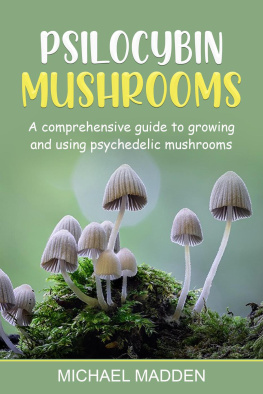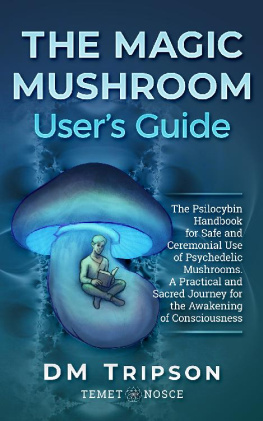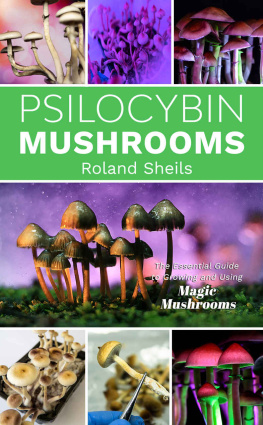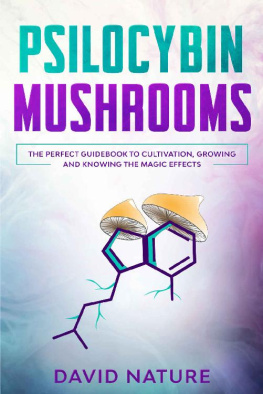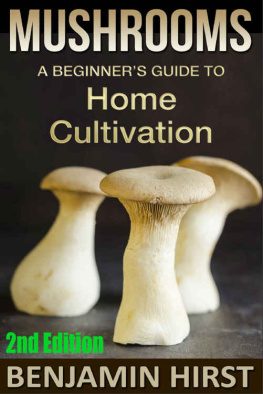Psilocybin Mushrooms
extended version
Everything You Need to Know About Magic Mushrooms From History to Medical Perspective.
A Real Guide to Cultivation and Safe Use
JONATHAN SYRIAN
Copyright 2020 by Jonathan Syrian
All rights reserved
This document is geared towards providing exact and reliable information with regards to the topic and issue covered. The publication is sold with the idea that the publisher is not required to render accounting, officially permitted, or otherwise, qualified services. If advice is necessary, legal or professional, a practiced individual in the profession should be ordered.
From a Declaration of Principles which was accepted and approved equally by a Committee of the American Bar Association and a Committee of Publishers and Associations. In no way is it legal to reproduce, duplicate, or transmit any part of this document in either electronic means or in printed format. Recording of this publication is strictly prohibited and any storage of this document is not allowed unless with written permission from the publisher. All rights reserved.
The information provided herein is stated to be truthful and consistent, in that any liability, in terms of inattention or otherwise, by any usage or abuse of any policies, processes, or directions contained within is the solitary and utter responsibility of the recipient reader. Under no circumstances will any legal responsibility or blame be held against the publisher for any reparation, damages, or monetary loss due to the information herein, either directly or indirectly.
Respective authors own all copyrights not held by the publisher.
The information herein is offered for informational purposes solely, and is universal as so. The presentation of the information is without contract or any type of guarantee assurance.
The trademarks that are used are without any consent, and the publication of the trademark is without permission or backing by the trademark owner. All trademarks and brands within this book are for clarifying purposes only and are the owned by the owners themselves, not affiliated with this document
Table of Contents
Chapter One
Introduction to Mushrooms

M ushrooms have been a part of the human diet for centuries. They have been a part of meals even before their proper discovery. People have been using them in their special meals and medicines, but they didn't know the actual name of it. Mushroom and its use as edibles by humans have a long history. With the development in food style, the style of using mushrooms was also changed. Humans are familiar with mushrooms long before the use of microorganisms. Mushroom is a fungus, and a proper definition of it was presented by Chang and Miles, where they said that a mushroom is a macro fungus which has a distinctive fruiting body, either epigeous or hypogenous, which is sizeable enough to be seen with the eye and picked by hand. They were not only used in Europe but also in the early Roman Empire, in Middle America, South America, and in Asia as part of special meals. Before the cultivation of mushrooms by man, they were found in the sediments of Lakes in Germany, Switzerland, and Austria. People didn't know anything about those umbrella-shaped puffballs found in moist places in prehistoric times. In ancient Greece and Rome, the toughest and hardest mushrooms like truffle and orange were the most expensive mushrooms.
Mushroom Usage in Prehistoric Times
Prehistoric times had evidence of mushroom usage in meals and medicines, but the exact time and place of its discovery are not clear. The Saharan aboriginal tribes of North Africa were possibly using mushrooms, as their stone painting showed, which were carved around 9000BC. In Spain, similar paintings were discovered, carved 6000 years ago. This evidence showed that some mushrooms were used in some specific rituals, and they were part of cultural meals as well. As per Egyptian culture and history of mushrooms, Egyptians considered mushrooms as "plants of immortality. Egyptian Pharaohs seemed interested in mushrooms so much that they announced and proclaimed that it is a special fruit meant only for gods. Therefore, in Egypt during the reign of Pharaohs, mushroom was considered an essential part of royalty meals.
Other civilizations of the world also considered mushrooms as something having superpowers. In Russia, China, Latin America, Mexico and Greece, mushroom was an essential part of some of their rituals. At some point, people thought that eating mushrooms could produce superhuman powers, and can lead a person on a path towards the gods.
History of Mushroom Cultivation
The cultivation of mushrooms was started back in 600s, in Asia. But in Europe, the fungus (mushroom) cultivation was started in the 1600s. History shows that the cultivation of mushrooms in Paris was started in the 1650s when a native farmer saw growing fungus in his field of melons. He then thought to cultivate this fungus on a commercial level, and this was the time to change thoughts about mushrooms. He delivered this umbrella-shaped fungus to restaurants where it was used as a dish. That type of mushrooms was named "Parisian Mushroom."
Researchers found fungus growing in caves around Paris, whose history dates back in the 1600s when French gardeners found that the humid and cool environment of caves is suitable for mushroom cultivation. Therefore mushrooms were cultivated at large scale in caves. In the Netherlands, mushrooms were introduced for cultivation in the 1800s but in small scales. Then after some time, large scale cultivation of mushrooms was done in marl mines in Limburg. After caves and mines, other methods of mushroom cultivation were developed, which then resulted in high mushroom yields in the region. Before that, mushrooms were specific, and they were only available for elites. Dutch people had the strictest rules and controls for mushroom cultivation. This was the reason the Netherlands became the largest mushroom producing country 50 years ago. However, China and the USA joined the competition of mushroom cultivation. China produces about 70% of the world's mushrooms now, so China is at the first position in mushroom cultivation, and then comes the USA and Netherlands.
Types and Classification of Mushrooms
Types of Mushrooms
In general, mushrooms are divided into four categories including, Edible mushrooms, Medicine or therapeutic mushrooms, Poisonous mushrooms, and Miscellaneous (mix) mushrooms.
Edible mushrooms: These mushrooms can be used in the human diet. They have been a part of meals for centuries in different civilizations. Some examples of these mushrooms are Cantharellus cibarius, Hericium erinaceus, Boletus edulis, etc.
Medicinal or Therapeutic mushrooms
Hundreds of mushroom species have therapeutic and healing properties, and therefore many of them are used in medicines. Some mushrooms having hallucinogenic properties are also considered as natural healers. For example, an old healer from Mexico, Maria Sabina, used hallucinogenic Psilocybin mushrooms to heal mental, spiritual, and physical problems. Examples of some therapeutic mushrooms are Fomitopsis pinicola, Hericium erinaceus, inonotus obliquus, etc.


